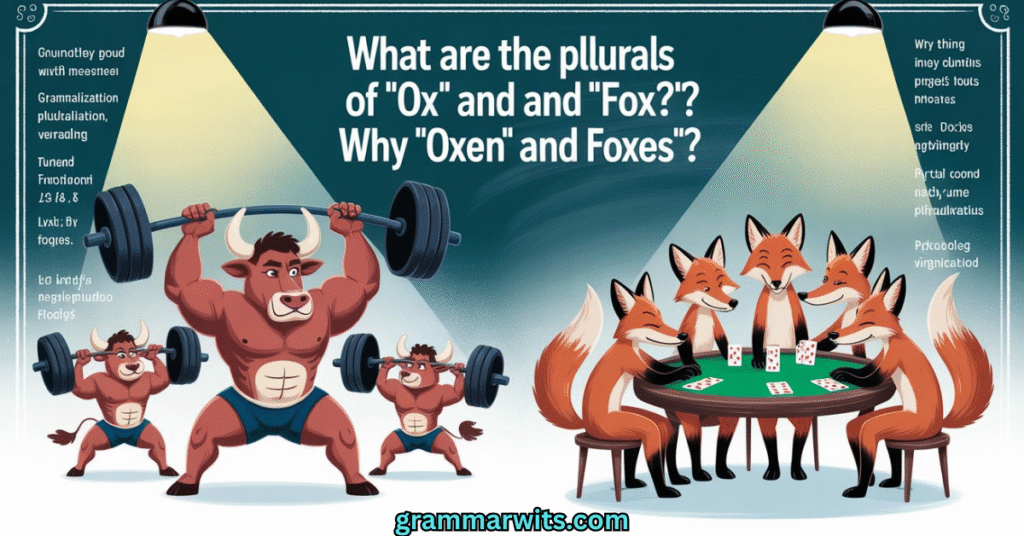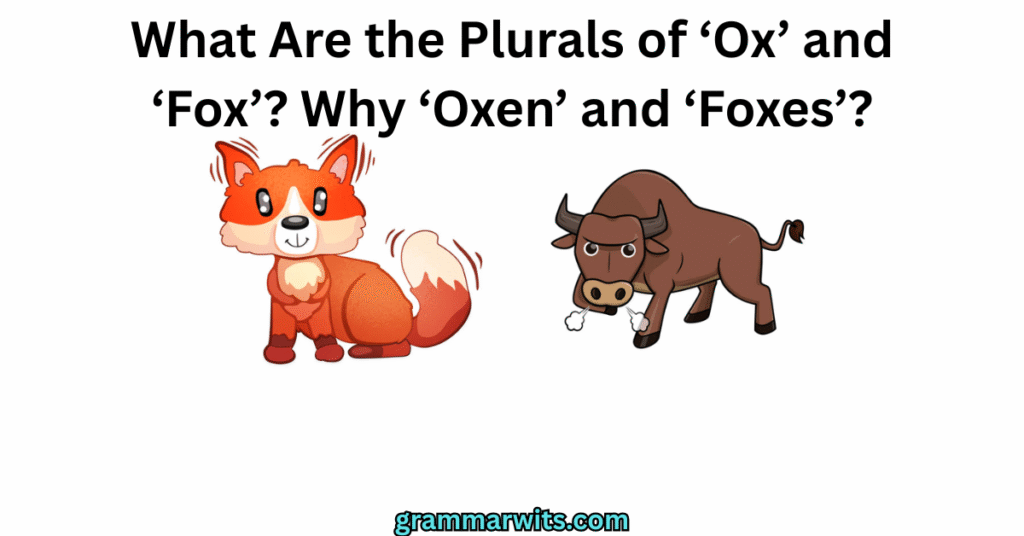The phrase “What are the plurals of ‘ox’ and ‘fox’?” refers to how the English language handles turning these singular animal names into their proper plural forms. While “fox” follows the predictable path to become “foxes,” “ox” takes a more unusual turn, transforming into “oxen.” This highlights a contrast between modern grammatical rules and historical linguistic influences. Understanding this difference offers insight into the quirks of English word formation.
This unexpected mix of regular and irregular pluralization isn’t just a grammar lesson—it’s a peek into the evolution of English itself. It grabs attention because it blends logic with linguistic legacy. Few words exemplify this better than “oxen,” a remnant of Old English still holding its ground today. For language lovers, these plural forms tell a story beyond simple spelling rules.
Both ox and fox come from ancient roots, yet their paths diverged over centuries. The strong, sturdy ox, once a vital part of farming societies, retained its historical plural. The clever fox, on the other hand, adapted to modern patterns. These distinctions enrich our understanding of animals and language alike, making even the simplest nouns a window into history.
Quick Answer: The Essential Difference
The plural of ox is oxen (irregular plural), while the plural of fox is foxes (regular plural). This difference stems from their distinct historical origins and language evolution in English.
Here’s the breakdown:
- Ox → Oxen (follows ancient Germanic patterns)
- Fox → Foxes (follows standard modern English rules)
But there’s a captivating story behind these grammatical exceptions that goes back over a thousand years.
The ‘Ox’ Deep Dive: Ancient Germanic Heritage

Etymology Behind the Irregular Form
The word ox traces back to Old English “oxa,” which connects to Proto-Germanic “*uksōn.” This ancient lineage explains why oxen defies modern English grammar rules. The ox vs oxen relationship preserves linguistic patterns from medieval times.
Anglo-Saxon communities relied heavily on cattle for farming and transportation. Their frequent use of ox and oxen helped these irregular plural nouns survive centuries of language change. While most Old English plurals disappeared, agricultural terms like oxen remained embedded in daily speech.
The Germanic connection becomes clear when comparing related languages. German uses “Ochse” (singular) and “Ochsen” (plural), while Dutch has “os” and “ossen.” These similarities show how oxen maintains its ancient word structure.
Understanding Weak Noun Declension
Old English classified nouns into strong and weak categories based on their word formation patterns. Ox belonged to the weak noun group, which added “-an” or “-en” endings for plurals. This morphology system created oxen instead of the expected “oxes.”
Other survivors from this weak declension include:
- Children (from “cild”)
- Brethren (archaic for “brothers”)
- Kine (archaic plural of “cow”)
Most weak nouns eventually adopted regular patterns, but oxen persisted due to cultural importance and frequent usage in animal grammar contexts.
Modern Usage Applications
Today, oxen appears primarily in agricultural writing, historical texts, and biblical references. Farmers discussing draft animals correctly use oxen when referring to multiple castrated bulls used for labor. The term also appears in place names like “Oxford” (literally “ox ford”).
Comparative grammar studies often highlight oxen as a prime example of linguistic history preserved in modern speech. Writers specializing in rural themes or historical fiction must master this irregular vs regular plurals distinction.
The ‘Fox’ Analysis: Standard Pattern Excellence

Following Modern English Rules
Unlike ox, the word fox follows predictable English plural rules. Fox entered Middle English from Old English “fox,” but it adapted to standardized pluralization in English patterns. The fox vs foxes transformation demonstrates how most animal names conform to regular systems.
Fox ends in ‘x’, triggering the adding “es” in plural rule. This syntax variations principle applies consistently across English vocabulary. The pronunciation flows naturally because adding just ‘s’ to fox would create an unpronounceable consonant cluster.
This regularity makes foxes easier for English learners to master compared to oxen. Fox plural formation follows the same pattern as boxes, mixes, and fixes—creating predictable language patterns.
The Standard -ES Rule Explained
Nouns ending in x require “-es” rather than simple “-s” additions. This noun inflection rule prevents pronunciation difficulties and maintains phonetic clarity. How to pluralize words ending in x, s, z, ch, or sh follows this consistent pattern.
Examples of this rule include:
- Box → Boxes
- Mix → Mixes
- Tax → Taxes
- Buzz → Buzzes
- Church → Churches
Foxes fits perfectly within this English word evolution framework, unlike the grammatical exceptions seen with oxen.
Pronunciation and Phonetics
The foxes plural creates a natural two-syllable word (fox-es), while hypothetical “fox’s” would be impossible to pronounce clearly. This phonetic necessity drove the language patterns that standardized “-es” endings for x-final words.
Regional dialects maintain consistent foxes pronunciation across English-speaking countries. This uniformity contrasts sharply with some irregular plural nouns that vary by location.
Historical Linguistics: Survival of the Fittest Words

Language Evolution Factors
Frequency of usage determined which irregular plurals survived English’s transformation. Oxen persisted because cattle remained central to agricultural communities throughout medieval and early modern periods. The ox and oxen distinction stayed relevant across centuries of farming tradition.
Norman French influence after 1066 standardized many English grammar plural rules, but everyday agricultural terms like oxen resisted change. Common words with irregular patterns tend to maintain their uniqueness longer than rarely used vocabulary.
The comparative grammar of English shows this pattern repeatedly. High-frequency irregulars like “children,” “mice,” and oxen survived, while obscure irregular forms disappeared or regularized.
Cultural Significance Impact
Anglo-Saxon society valued cattle as wealth symbols and working animals. This cultural importance protected oxen from linguistic standardization pressures. Fox, while present in folklore and hunting, lacked the same economic significance.
Biblical translations also preserved oxen in religious contexts. Phrases like “fatted calf” and references to oxen in parables kept these irregular vs regular plurals alive in formal language.
Medieval literature frequently mentioned oxen in agricultural contexts, while foxes appeared mainly in fables and hunting stories. This usage difference influenced which plural word formation patterns survived.
Memory Tricks for Perfect Usage
Effective Mnemonics
Remember oxen with the phrase “Oxen like men—both end in -en.” This connection to the familiar “man/men” irregular pattern helps cement the correct ox plural form.
For foxes, think “Foxes in boxes”—both follow the standard “-es” rule. This mental link reinforces proper pluralization in English for x-ending words.
Visual learners can picture oxen pulling medieval plows, emphasizing their ancient origins. Meanwhile, imagine foxes running through modern forests, representing their standard plural formation.
Common Writing Mistakes
Writers often create “oxes” by incorrectly applying regular English plural rules to ox. This error appears frequently in student essays and informal writing. Professional editors consistently flag this mistake.
Another common error involves possessive forms. “The oxen’s strength” is correct, while “the oxens’ strength” is wrong. Oxen already represents the plural, so it takes apostrophe-s for possession.
Comparative grammar exercises help writers master these distinctions through repetition and context.
Professional Writing Applications
Academic and Agricultural Contexts
Scientific papers discussing cattle breeding or agricultural history require precise oxen usage. Veterinary journals, farming publications, and historical research demand accurate irregular plural nouns throughout their content.
Legal documents involving livestock often specify oxen in contracts or insurance policies. Property descriptions mentioning draft animals must distinguish between ox and oxen for clarity.
Style guides from major publications like The Chicago Manual of Style and AP Stylebook explicitly address irregular vs regular plurals including oxen examples.
International English Variations
British, American, Canadian, and Australian English maintain consistent oxen and foxes forms. Unlike some vocabulary differences between English variants, these animal plural forms remain standardized globally.
Business communications involving international agricultural trade use oxen universally. This consistency prevents confusion in global markets dealing with livestock terminology.
Related Irregular Patterns Worth Knowing
Understanding oxen opens doors to other English word irregularities. Similar patterns include:
| Singular | Plural | Pattern Type |
|---|---|---|
| Child | Children | Weak declension |
| Foot | Feet | Vowel mutation |
| Mouse | Mice | Vowel mutation |
| Goose | Geese | Vowel mutation |
| Deer | Deer | Zero marking |
These lexical category examples show how Old English influences persist in modern English grammar rules. Each represents different historical morphology systems that shaped contemporary usage.
Foreign loan words sometimes retain original plurals, like “alumni” from Latin or “phenomena” from Greek. These additions expand English’s irregular plural nouns beyond Germanic origins.
Embracing English’s Linguistic Heritage
The ox and fox plural distinction showcases English’s rich linguistic history. Oxen preserves thousand-year-old language patterns, while foxes demonstrates modern standardization success.
These grammatical exceptions remind us that languages evolve organically rather than through rigid rules. English word evolution creates fascinating irregularities that connect us to our linguistic ancestors.
Writers who master both oxen and foxes demonstrate sophisticated understanding of English grammar plural rules. This knowledge elevates writing quality and shows respect for language tradition.
Comprehensive FAQ Section
Is “oxes” ever correct? No, “oxes” is never correct in standard English. The only accepted plural of ox is oxen. This irregular plural form has remained consistent for over a thousand years.
Are there other animals with irregular plurals? Yes, several animal names use irregular patterns: mouse/mice, goose/geese, and sheep/sheep. However, most modern animal plural forms follow regular rules like foxes.
Do other languages have similar irregular patterns? Germanic languages like German and Dutch maintain similar irregularities. However, Romance languages tend toward more regular pluralization systems than English.
What about compound words with ‘ox’ or ‘fox’? Compounds follow the main noun’s pattern: “ox-carts” becomes “ox-carts” (treating “carts” as the plural), while “foxhounds” pluralizes the entire compound as “foxhounds.”
Are there regional differences in these plurals? No significant regional variations exist for oxen and foxes. These forms remain consistent across all major English dialects worldwide.
What’s the possessive form of ‘oxen’ and ‘foxes’? Oxen takes apostrophe-s: “the oxen’s strength.” Foxes takes apostrophe alone: “the foxes’ den.” This follows standard possessive rules for irregular and regular plurals.
How old are these plural forms? Oxen dates to Old English (before 1100 CE), while foxes emerged during Middle English (1100-1500 CE) as regularization occurred.
Why do some irregulars survive while others disappear? Frequency of usage and cultural importance determine survival. Oxen remained relevant in agricultural societies, while rare irregular forms fell out of use and regularized.
The journey from ox to oxen and fox to foxes illustrates English’s remarkable ability to preserve ancient patterns while adapting to modern needs. These English word irregularities enrich our language and connect us to centuries of linguistic heritage.

Alizy Smith is a passionate language enthusiast and the admin of Grammar Wits. With a love for wordplay, grammar quirks, and witty expressions, she’s dedicated to making language learning fun and accessible. From grammar tips to pun-filled laughs, Alizy ensures every piece of content entertains while educating — turning tricky rules into easy, enjoyable reads.
